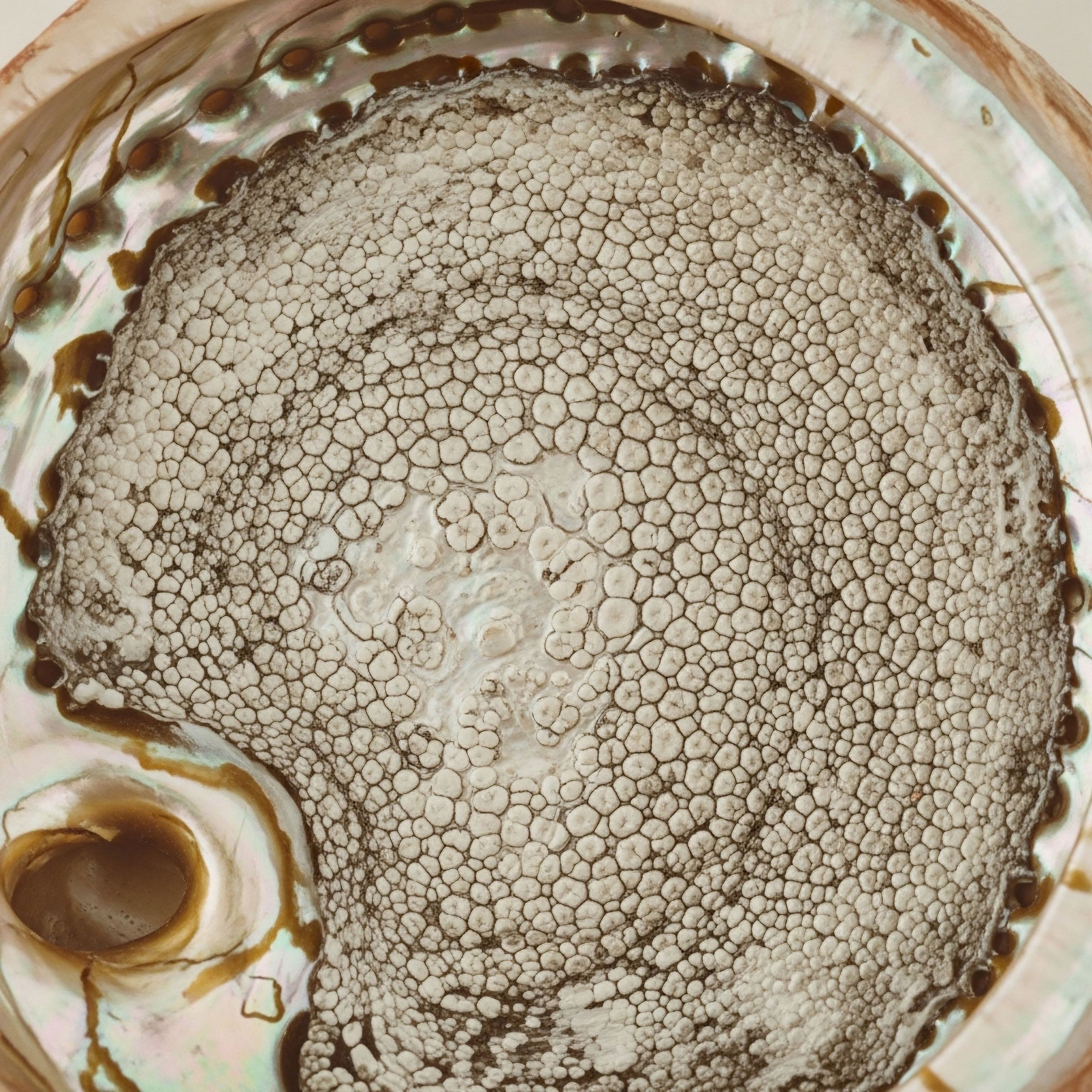

Fundamentals
Many individuals experience a subtle, yet persistent, shift as the years progress. Perhaps it begins with a slight decrease in morning vigor, a feeling of needing more rest without truly feeling rested, or a diminished capacity for physical activity that once felt effortless.
Some notice a quiet change in their mental clarity, a less vibrant mood, or a recalibration of their physical composition, even with consistent effort. These experiences are not merely subjective perceptions; they often represent genuine physiological adjustments within the body, signaling a deeper conversation occurring within your biological systems.
Understanding these internal dialogues, particularly those orchestrated by the endocrine system, provides a powerful lens through which to view these changes. Your body possesses an extraordinary network of glands and organs that produce and release chemical messengers known as hormones. These substances act as vital signals, traveling through the bloodstream to orchestrate nearly every bodily function, from metabolism and energy production to mood regulation and reproductive health.
Hormones serve as the body’s essential internal messaging service, coordinating a vast array of physiological processes.
As we age, the production and sensitivity of these hormonal messengers can undergo significant alterations. This is not a uniform decline across all individuals or all hormones; rather, it is a complex, individualized process influenced by genetics, lifestyle, environmental factors, and cumulative physiological stress. Recognizing these shifts as a potential source of your current experiences marks the initial step toward understanding how targeted interventions might support your vitality.

Decoding Your Body’s Signals
The sensations you experience ∞ the fatigue, the altered sleep patterns, the changes in body composition, or the shifts in cognitive function ∞ are the body’s way of communicating. These are not isolated incidents but often interconnected expressions of underlying systemic adjustments. For instance, a persistent lack of energy might point to suboptimal thyroid function, adrenal fatigue, or a decline in gonadal hormone output.
Consider the intricate feedback loops that govern hormone production. The hypothalamic-pituitary-gonadal (HPG) axis, for example, functions much like a sophisticated thermostat system. The hypothalamus in the brain sends signals to the pituitary gland, which then instructs the gonads (testes in men, ovaries in women) to produce sex hormones like testosterone and estrogen.
This system constantly monitors hormone levels, adjusting production to maintain balance. When this delicate balance is disrupted, the downstream effects can manifest as the very symptoms many individuals attribute to “just getting older.”

The Endocrine System an Internal Dialogue
The endocrine system’s components communicate continuously, influencing one another in a complex web of interactions. For instance, adrenal hormones, which manage stress responses, can directly impact thyroid function and sex hormone production. Similarly, metabolic health, governed by hormones like insulin and leptin, is inextricably linked to the optimal functioning of the entire endocrine network.
Viewing these physiological shifts through the lens of hormonal communication allows for a more precise and personalized approach to wellness. Instead of simply addressing symptoms, the focus shifts to understanding the root cause of the biological imbalance. This perspective acknowledges your unique biological blueprint and seeks to recalibrate the body’s inherent regulatory mechanisms, rather than merely masking the outward expressions of systemic dysregulation.
The possibility of supporting these internal systems to restore more youthful physiological function is a compelling area of modern clinical science. This involves a careful assessment of individual hormonal profiles, metabolic markers, and lifestyle factors to develop a protocol that aligns with your body’s specific requirements. It represents a proactive stance toward health, aiming to optimize biological function and enhance the quality of life as the years advance.


Intermediate
Once a comprehensive understanding of an individual’s hormonal landscape is established, the conversation naturally progresses to targeted interventions. These protocols are designed to address specific deficiencies or imbalances, aiming to restore physiological function and alleviate the associated symptoms. The selection of a particular therapeutic agent or peptide is a precise process, guided by clinical assessment, laboratory data, and the individual’s unique health objectives.
The underlying principle of these interventions involves providing the body with the specific biochemical signals it requires to operate optimally. This is not about forcing a system into an unnatural state, but rather about supporting its innate capacity for balance and self-regulation. Each protocol is tailored, recognizing that what works for one individual may not be appropriate for another, even with similar presenting concerns.

Testosterone Replacement Therapy for Men
For men experiencing symptoms associated with declining testosterone levels, often referred to as andropause or hypogonadism, Testosterone Replacement Therapy (TRT) offers a pathway to physiological recalibration. This condition can manifest as reduced energy, diminished libido, changes in body composition, and alterations in mood. The standard approach typically involves the administration of bioidentical testosterone to restore circulating levels to a more optimal range.
A common protocol involves weekly intramuscular injections of Testosterone Cypionate (200mg/ml). This method provides a steady release of the hormone, helping to maintain consistent physiological levels. To mitigate potential side effects and preserve endogenous function, TRT protocols often incorporate additional agents:
- Gonadorelin ∞ Administered via subcutaneous injections, typically twice weekly. This peptide stimulates the pituitary gland to release Luteinizing Hormone (LH) and Follicle-Stimulating Hormone (FSH), thereby supporting the testes’ natural testosterone production and maintaining fertility.
- Anastrozole ∞ An oral tablet taken twice weekly. This medication acts as an aromatase inhibitor, blocking the conversion of testosterone into estrogen. Managing estrogen levels is crucial to prevent side effects such as gynecomastia or fluid retention, which can occur when testosterone levels rise.
- Enclomiphene ∞ In some cases, this medication may be included. It selectively modulates estrogen receptors in the hypothalamus and pituitary, encouraging the body’s own production of LH and FSH, further supporting natural testicular function.
The goal of male TRT extends beyond simply raising testosterone numbers; it aims to restore a sense of vitality, improve body composition, enhance cognitive function, and support overall well-being. Regular monitoring of blood parameters, including testosterone, estrogen, and hematocrit, ensures the protocol remains safe and effective.

Testosterone Replacement Therapy for Women
Women also experience age-related hormonal shifts, particularly during peri-menopause and post-menopause, which can significantly impact their quality of life. Symptoms such as irregular cycles, mood fluctuations, hot flashes, and reduced libido are common. Targeted hormonal support for women focuses on balancing estrogen, progesterone, and testosterone to alleviate these concerns and optimize physiological function.
Protocols for women’s hormonal balance are highly individualized:
- Testosterone Cypionate ∞ Typically administered in very low doses, such as 10 ∞ 20 units (0.1 ∞ 0.2ml) weekly via subcutaneous injection. This dosage is significantly lower than male protocols, reflecting women’s physiological requirements. Testosterone in women supports libido, bone density, muscle mass, and cognitive clarity.
- Progesterone ∞ Prescribed based on menopausal status and individual needs. For pre-menopausal women with irregular cycles, it can help regulate the menstrual cycle. For peri- and post-menopausal women, it is often used to balance estrogen and protect the uterine lining.
- Pellet Therapy ∞ Offers a long-acting delivery method for testosterone. Small pellets are inserted subcutaneously, providing a consistent release of the hormone over several months. Anastrozole may be used in conjunction with pellet therapy when appropriate, particularly if there is a tendency for testosterone to convert excessively to estrogen.
The careful titration of these hormones aims to alleviate bothersome symptoms, improve energy levels, enhance sexual health, and support long-term bone and cardiovascular health. The approach prioritizes restoring a physiological balance that supports the woman’s unique biological needs.

Post-TRT or Fertility-Stimulating Protocol for Men
For men who have discontinued TRT or are actively seeking to conceive, a specific protocol is implemented to stimulate the body’s natural hormone production and restore fertility. TRT, while effective, can suppress the body’s endogenous testosterone production and spermatogenesis. This protocol aims to reactivate the HPG axis.
The protocol typically includes a combination of agents:
- Gonadorelin ∞ Continues to stimulate LH and FSH release, directly encouraging testicular function.
- Tamoxifen ∞ A selective estrogen receptor modulator (SERM) that blocks estrogen’s negative feedback on the hypothalamus and pituitary, thereby increasing LH and FSH secretion.
- Clomid (Clomiphene Citrate) ∞ Another SERM that works similarly to Tamoxifen, promoting the release of gonadotropins and stimulating endogenous testosterone production.
- Anastrozole ∞ Optionally included to manage estrogen levels, particularly if the increase in endogenous testosterone leads to elevated estrogen conversion.
This strategic combination helps to restart the body’s own hormonal machinery, facilitating a smoother transition off exogenous testosterone and supporting reproductive goals.

Growth Hormone Peptide Therapy
Peptide therapy represents a sophisticated approach to optimizing various physiological functions, particularly those related to growth hormone (GH) secretion. These peptides are not synthetic growth hormone; rather, they are secretagogues that stimulate the body’s own pituitary gland to release more natural GH. This can lead to a range of benefits, including improved body composition, enhanced recovery, and better sleep quality.
Key peptides utilized in these protocols include:
- Sermorelin ∞ A growth hormone-releasing hormone (GHRH) analog that stimulates the pituitary to release GH. It is often used for its anti-aging properties, promoting cellular repair and regeneration.
- Ipamorelin / CJC-1295 ∞ These are often combined. Ipamorelin is a selective GH secretagogue that promotes GH release without significantly affecting other hormones like cortisol. CJC-1295 is a GHRH analog that has a longer half-life, providing a sustained release of GH. Their combination offers a potent stimulus for GH secretion, supporting muscle gain and fat loss.
- Tesamorelin ∞ A GHRH analog specifically approved for reducing visceral fat in certain conditions. It can be beneficial for individuals seeking targeted fat reduction and metabolic improvement.
- Hexarelin ∞ A potent GH secretagogue that also has cardioprotective effects. It can support muscle growth and overall recovery.
- MK-677 (Ibutamoren) ∞ An oral GH secretagogue that stimulates GH release by mimicking the action of ghrelin. It is often used to improve sleep quality, increase muscle mass, and reduce body fat.
These peptides are typically administered via subcutaneous injection, with specific dosing regimens tailored to individual goals and physiological responses.

Other Targeted Peptides
Beyond growth hormone secretagogues, other peptides offer specialized therapeutic applications:
- PT-141 (Bremelanotide) ∞ This peptide acts on melanocortin receptors in the brain to address sexual dysfunction. It can enhance libido and arousal in both men and women, offering a unique mechanism of action compared to traditional treatments.
- Pentadeca Arginate (PDA) ∞ A peptide designed to support tissue repair, accelerate healing processes, and modulate inflammatory responses. It holds promise for individuals recovering from injuries or seeking to manage chronic inflammatory conditions.
The application of these targeted peptides represents a sophisticated frontier in personalized wellness, offering precise biological signaling to address specific physiological needs.
| Intervention Type | Primary Target Audience | Key Physiological Goals | Common Administration Method |
|---|---|---|---|
| Testosterone Replacement (Men) | Middle-aged to older men with low testosterone symptoms | Restore energy, libido, muscle mass, mood stability | Weekly intramuscular injection |
| Testosterone Replacement (Women) | Pre/peri/post-menopausal women with relevant symptoms | Improve libido, bone density, mood, energy | Weekly subcutaneous injection or pellet therapy |
| Growth Hormone Peptides | Active adults, athletes seeking anti-aging, recovery | Enhance muscle gain, fat loss, sleep quality, cellular repair | Subcutaneous injection |
| PT-141 | Individuals with sexual health concerns | Improve libido and arousal | Subcutaneous injection |
| Pentadeca Arginate (PDA) | Individuals seeking tissue repair, inflammation modulation | Accelerate healing, reduce inflammation | Subcutaneous injection |
Each of these protocols requires careful medical supervision, including initial comprehensive assessment and ongoing monitoring, to ensure safety and optimize outcomes. The aim is always to support the body’s inherent capacity for health and resilience, guiding it back towards a state of optimal function.


Academic
The concept of reversing age-related physiological declines through targeted hormonal interventions moves beyond symptomatic relief, delving into the intricate mechanisms of systemic biology. This academic exploration focuses on the interconnectedness of the endocrine system, particularly the hypothalamic-pituitary-gonadal (HPG) axis, with broader metabolic pathways and inflammatory processes. Understanding these deep biological relationships provides the scientific underpinning for precision medicine in longevity and functional restoration.
Age-related changes in hormonal output are not isolated events; they represent a complex interplay of genetic predispositions, environmental exposures, and cumulative cellular stress. The HPG axis, a central regulator of reproductive and anabolic hormones, serves as a prime example of this systemic interconnectedness. Its decline with age, often termed somatopause for growth hormone and andropause or menopause for gonadal hormones, contributes significantly to the constellation of symptoms associated with biological aging.
Age-related hormonal shifts are deeply intertwined with metabolic function and systemic inflammation, forming a complex web of physiological interactions.

The Hypothalamic-Pituitary-Gonadal Axis and Aging
The HPG axis operates through a sophisticated feedback loop. The hypothalamus releases gonadotropin-releasing hormone (GnRH), which stimulates the anterior pituitary to secrete luteinizing hormone (LH) and follicle-stimulating hormone (FSH). These gonadotropins then act on the gonads ∞ the testes in men and ovaries in women ∞ to produce sex steroids (testosterone, estrogen, progesterone) and support gamete maturation.
With advancing age, changes occur at multiple levels of this axis. In men, there is often a primary testicular failure, leading to reduced testosterone production despite potentially normal or even elevated LH levels, indicating a compensatory pituitary response. This is known as compensated hypogonadism.
In women, ovarian follicular depletion leads to a precipitous decline in estrogen and progesterone, triggering a significant increase in FSH and LH as the pituitary attempts to stimulate non-responsive ovaries. These shifts have profound systemic consequences.
Targeted interventions, such as Testosterone Replacement Therapy (TRT), aim to restore physiological levels of these crucial hormones. For instance, exogenous testosterone administration in men directly addresses the gonadal insufficiency. However, the judicious use of agents like Gonadorelin or Clomiphene Citrate demonstrates a deeper understanding of the HPG axis.
These compounds work upstream, stimulating the pituitary to produce LH and FSH, thereby encouraging the body’s own testicular function and preserving fertility, a critical consideration for many individuals. This approach respects the body’s inherent regulatory mechanisms, rather than simply overriding them.

Metabolic Interplay and Hormonal Homeostasis
The endocrine system does not operate in isolation; its function is inextricably linked to metabolic health. Hormones like testosterone and estrogen play direct roles in regulating insulin sensitivity, glucose metabolism, and lipid profiles. A decline in these sex hormones can contribute to the development of insulin resistance, increased visceral adiposity, and dyslipidemia, all hallmarks of metabolic dysfunction.
For example, reduced testosterone in men is frequently associated with an increased risk of metabolic syndrome and type 2 diabetes. Testosterone influences glucose uptake in muscle and adipose tissue, and its deficiency can impair insulin signaling pathways. Similarly, the decline in estrogen during menopause contributes to changes in fat distribution, favoring central adiposity, and can worsen insulin sensitivity in women.
Growth hormone (GH) and its downstream mediator, insulin-like growth factor 1 (IGF-1), are also critical metabolic regulators. Age-related decline in GH secretion, known as somatopause, contributes to reduced lean muscle mass, increased fat mass, and altered lipid metabolism. Peptide therapies like Sermorelin or Ipamorelin/CJC-1295, by stimulating endogenous GH release, can help recalibrate these metabolic parameters.
These peptides promote lipolysis (fat breakdown) and protein synthesis, supporting a more favorable body composition and potentially improving insulin sensitivity. The precise modulation of these pathways offers a powerful strategy for mitigating age-related metabolic decline.
| Hormone | Key Metabolic Influence | Impact of Decline | Potential Intervention Benefit |
|---|---|---|---|
| Testosterone | Insulin sensitivity, glucose uptake, lean mass | Increased insulin resistance, visceral fat, muscle loss | Improved insulin sensitivity, reduced adiposity, enhanced muscle anabolism |
| Estrogen | Fat distribution, lipid profile, glucose metabolism | Central adiposity, dyslipidemia, impaired glucose tolerance | Favorable fat distribution, improved lipid markers, better glucose control |
| Growth Hormone (GH) | Protein synthesis, lipolysis, glucose utilization | Reduced lean mass, increased fat mass, altered lipid metabolism | Enhanced body composition, improved metabolic flexibility |
| Insulin | Glucose regulation, nutrient storage | Hyperglycemia, cellular energy deficits | Optimized glucose transport, stable energy levels |

Inflammation and Endocrine Dysregulation
Chronic low-grade inflammation, often termed inflammaging, is a significant contributor to age-related physiological decline and is intimately linked with endocrine dysregulation. Adipose tissue, particularly visceral fat, is an active endocrine organ that secretes pro-inflammatory cytokines such as TNF-alpha, IL-6, and leptin. These inflammatory mediators can directly impair insulin signaling and disrupt the delicate balance of the HPG axis.
For instance, elevated inflammatory markers can suppress GnRH pulsatility and reduce testicular testosterone production in men. In women, inflammation can exacerbate menopausal symptoms and contribute to conditions like polycystic ovary syndrome (PCOS) by disrupting ovarian function. Conversely, optimal levels of sex hormones, particularly testosterone and estrogen, possess anti-inflammatory properties, helping to modulate immune responses and protect against cellular damage.
Targeted hormonal interventions, by restoring physiological hormone levels, can indirectly contribute to a reduction in systemic inflammation. Improved body composition through TRT or GH peptide therapy, for example, can reduce the inflammatory burden from excess adipose tissue.
Additionally, certain peptides like Pentadeca Arginate (PDA) are being explored for their direct anti-inflammatory and tissue-repairing properties, offering another avenue for addressing the systemic impact of aging. The holistic view acknowledges that optimizing hormonal balance is not merely about addressing a single deficiency, but about recalibrating a complex, interconnected system to support overall health and resilience against age-related decline.
This comprehensive approach underscores the potential for targeted interventions to truly reverse, rather than simply manage, the physiological shifts associated with advancing years.

References
- Mooradian, Arshag D. et al. “Biological actions of androgens.” Endocrine Reviews, vol. 8, no. 1, 1987, pp. 1-28.
- Veldhuis, Johannes D. et al. “Physiological and pathophysiological consequences of growth hormone and insulin-like growth factor-I deficiency in adults.” Endocrine Reviews, vol. 18, no. 5, 1997, pp. 603-639.
- Davis, Susan R. et al. “Testosterone for women ∞ the clinical practice guideline of The Endocrine Society.” The Journal of Clinical Endocrinology & Metabolism, vol. 101, no. 10, 2016, pp. 3653-3669.
- Bhasin, Shalender, et al. “Testosterone therapy in men with hypogonadism ∞ an Endocrine Society clinical practice guideline.” The Journal of Clinical Endocrinology & Metabolism, vol. 103, no. 5, 2018, pp. 1715-1744.
- Katznelson, Lawrence, et al. “Growth hormone deficiency in adults ∞ an Endocrine Society clinical practice guideline.” The Journal of Clinical Endocrinology & Metabolism, vol. 94, no. 9, 2009, pp. 3149-3171.
- Handelsman, David J. and Christine E. Yeap. “Androgen physiology, pharmacology and abuse.” Endocrine Reviews, vol. 32, no. 5, 2011, pp. 690-715.
- Giustina, Andrea, et al. “Growth hormone and metabolism ∞ a review.” Journal of Endocrinological Investigation, vol. 37, no. 12, 2014, pp. 1151-1162.
- Boron, Walter F. and Emile L. Boulpaep. Medical Physiology. 3rd ed. Elsevier, 2017.
- Guyton, Arthur C. and John E. Hall. Textbook of Medical Physiology. 13th ed. Elsevier, 2016.

Reflection
The journey toward understanding your own biological systems is a deeply personal one, often beginning with a quiet recognition of shifts within your body. The knowledge presented here, from the foundational roles of hormones to the intricate details of targeted interventions, serves as a starting point. It is a framework for comprehending the complex language your body speaks, particularly as the years unfold.
Consider this information not as a definitive endpoint, but as an invitation to introspection. What are your body’s current signals communicating? How might a deeper understanding of your unique hormonal and metabolic landscape guide your path toward enhanced vitality? Reclaiming optimal function is not a passive process; it requires an active partnership with clinical expertise, translating scientific insights into a personalized strategy. Your biological blueprint holds the key to unlocking renewed energy and well-being.



